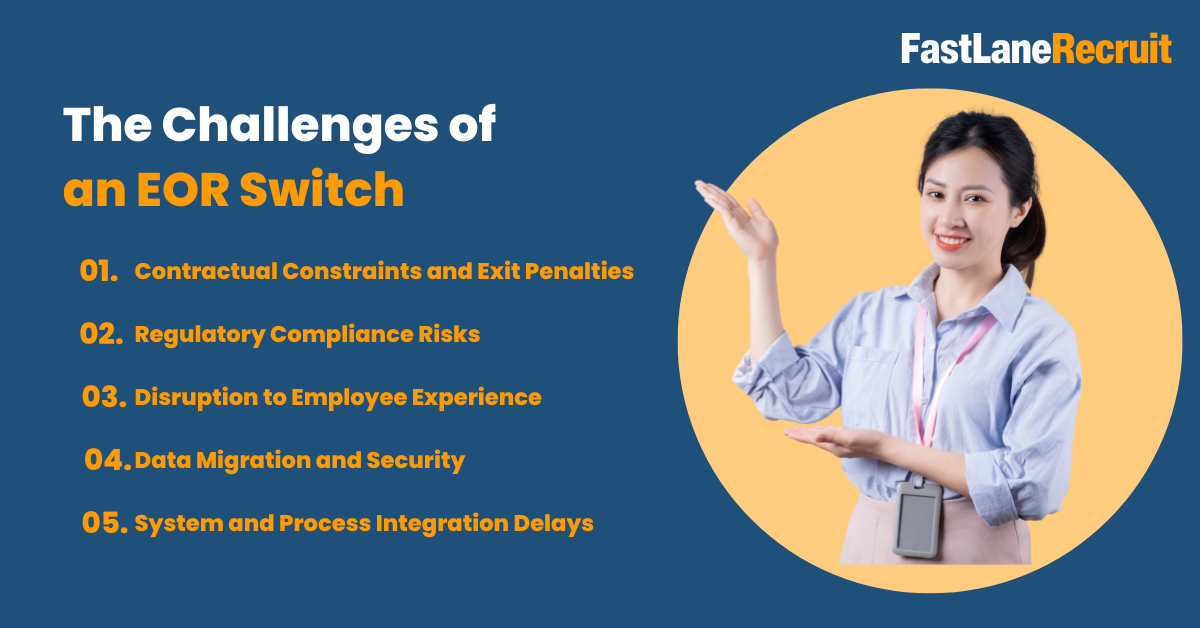The Employer of Record (EOR) model offers a smart, scalable solution for businesses expanding across borders without setting up a legal entity. But as priorities shift and operations grow more complex, your current EOR provider may no longer meet your company’s evolving needs. While switching EOR partners is a major step, it can be essential to ensure continued compliance, efficiency, and long-term success.
This guide explores the key reasons for switching EOR providers, outlines potential risks, and provides a practical roadmap to ensure a smooth and seamless transition for businesses managing remote teams across international talent hubs such as Malaysia.
Content Outline
Key Summary
Switching your EOR provider is often necessary when existing services no longer meet your company’s operational or compliance needs.
Common reasons for switching include limited service offerings, poor geographic coverage, and organizational misalignment.
The transition process presents significant challenges, such as contract restrictions, regulatory risks, employee disruption, data security concerns, and system integration issues.
A successful switch requires a structured plan, including legal review, provider evaluation, transparent communication, and phased execution.
FastLaneRecruit supports global companies by offering compliant, reliable EOR services in Malaysia, ensuring smooth onboarding, payroll, and HR operations.
With local expertise and transparent service agreements, FastLaneRecruit minimizes risk and maximizes operational efficiency for global expansion.
Why Would You Need to Switch EOR Service Providers?
Selecting the right EOR partner is pivotal to ensuring that your international operations are compliant, agile, and cost-efficient. Yet over time, deficiencies in service scope, geographic reach, or cultural alignment may prompt the need for a change.
Also Read: Best Practices for Remote Work Performance Management
Limited Services
Some EOR providers offer only basic payroll and compliance services. As your organization scales, the need for more holistic support, such as talent onboarding, benefits administration, and localized employee engagement strategies, becomes critical.
Table: Common Service Gaps in Legacy EOR Providers
| Service Area | Typical Gap | Business Impact |
| Onboarding | Delays or lack of localization | Poor candidate experience |
| Payroll Processing | Inflexible schedules or errors | Compliance risks, employee dissatisfaction |
| Benefits Administration | Limited local offerings | Reduced employee retention |
| Termination Handling | Non-compliant procedures | Legal exposure |
Isolated Coverage
Inadequate geographic coverage can be a serious limitation. If your EOR provider lacks presence or partnerships in strategic markets such as Southeast Asia or Latin America, you risk fragmented HR operations. For instance, expanding your team in Malaysia while your provider only has infrastructure in Western Europe poses operational friction and legal uncertainties.
Also Read: The Pros and Cons of Employers of Record
Poor Organizational Fit
An EOR partner must resonate with your company’s ethos. Misalignment in communication style, cultural understanding, or response time can degrade collaboration. A lack of transparency or unclear SLAs (Service Level Agreements) is often a red flag. Over time, this erodes trust and stifles growth.
The Challenges of an EOR Switch
Transitioning from one Employer of Record (EOR) provider to another is a multifaceted process that demands strategic planning, legal scrutiny, and operational precision. While the long-term benefits of switching to a better-aligned EOR partner may be compelling, companies must be prepared to navigate several complex challenges during the transition.

1. Contractual Constraints and Exit Penalties
Most EOR agreements contain legally binding clauses that outline the terms for termination. These often include notice periods, early termination penalties, and obligations to complete a full billing cycle before disengagement. Overlooking these terms may result in unexpected financial liabilities or legal disputes.
Before initiating a switch, it is essential to conduct a detailed review of the existing service agreement. Legal advice should be consulted to interpret clauses related to severance of the relationship and to ensure the transition complies with both local and international labor regulations. Companies are advised to review guidelines under the Federal Acquisition Regulation (FAR) when dealing with third-party contracts abroad.
Also Read: Why Do Companies Choose to Outsource?
2. Regulatory Compliance Risks
Switching EOR providers involves the deregistration and reregistration of employees in the host country. A process governed by local labor laws, tax codes, and social security regulations. Any error in timing, documentation, or reporting can lead to serious repercussions, including:
- Employee work permit lapses
- Tax withholding misalignments
- Breach of labor law obligations
- Fines or penalties from local authorities
For example, when transferring employees in Malaysia, it is critical to comply with the Malaysian Inland Revenue Board (LHDN) and Social Security Organisation (SOCSO), in addition to notifying the Employees Provident Fund (EPF).
3. Disruption to Employee Experience
Employees are at the heart of every EOR arrangement. A poorly managed provider switch can introduce uncertainty and anxiety among staff, especially when it affects pay cycles, benefits access, or legal work status.
Also Read: How to Pay International Employees
Key employee-related risks include:
- Interrupted payroll leading to dissatisfaction or legal claims
- Delays in insurance or benefit activation, particularly health coverage
- Lack of communication about what’s changing and why
To safeguard morale and retention, companies must maintain a high level of transparency and offer support throughout the process.
4. Data Migration and Security
Transferring sensitive employee data, such as contracts, salary history, tax identification numbers, and personal details, between two EOR systems carries significant data protection obligations. Mishandling such data can violate regulations under frameworks such as the General Data Protection Regulation (GDPR) for European employees or the California Consumer Privacy Act (CCPA) for U.S.-linked entities.
Organizations should ensure:
- Data is encrypted during transfer
- Access is restricted to authorized personnel only
- Both outgoing and incoming providers adhere to international data protection standards
5. System and Process Integration Delays
Each EOR provider typically uses its own proprietary software platforms and workflows for managing HR, payroll, and compliance. When switching providers, internal teams may need to adjust to new systems, retrain staff, and reconfigure integrations with existing internal tools (e.g., accounting software, time tracking platforms).
This period of dual-system management can strain internal HR or finance departments, particularly in the absence of robust transitional support from both providers.
Switching EOR providers is not a task to be undertaken lightly. It requires a well-documented plan, experienced legal and compliance guidance, and a partner that can ensure business continuity. Despite these challenges, a successful switch can unlock greater scalability, localized expertise, and operational clarity, benefits that far outweigh the temporary complexities of the transition.
Also Read: Hiring Malaysian Talent: Employer of Record Malaysia Guide
Ensuring a Successful EOR Switch
A seamless transition begins with meticulous planning and phased execution. The following roadmap outlines a best-practice approach:
1. Conduct a Provider Audit
Assess your current provider’s strengths and gaps. Define what your new partner must deliver, be it multilingual support, stronger regional compliance, or enhanced technology integration.
2. Review Contracts and Notice Periods
Understand your termination clauses. Engage legal experts to evaluate risks and negotiate exit terms, if necessary.
3. Vet New EOR Candidates Thoroughly
Look for certifications, testimonials, and proven expertise in the jurisdictions relevant to your business. Consider requesting compliance documentation such as local tax registration or employment licenses.
4. Design a Transition Timeline
Break the switch into phases:
| Transition Phase | Key Activities | Timeframe |
| Discovery & Planning | Identify new partner, review contracts | 2–4 weeks |
| Parallel Run | Set up payroll, test systems with both providers | 3–5 weeks |
| Employee Communication | Notify staff, offer Q&A sessions | Ongoing |
| Handover & Go Live | Migrate employees, deactivate old provider | 1–2 weeks |
5. Communicate Transparently
Early and frequent communication with employees is vital. Clarify what’s changing, what remains the same, and whom they can contact for support.
6. Monitor Post-Switch Activities
After the transition, audit the first few payroll cycles, check compliance filings, and gather feedback from employees and internal HR stakeholders.
Also Read: Outsourced Accounting – Frequently Asked Questions (FAQ)
Conclusion
Switching your EOR provider may initially seem daunting, but when carefully executed, it can revitalize operational efficiency, bolster compliance, and enhance employee satisfaction. For U.S.-based companies managing offshore teams, particularly in emerging markets like Malaysia, the right EOR partner is a competitive differentiator.
How FastLaneRecruit Supports Global Companies with EOR Services in Malaysia
FastLaneRecruit offers global companies a future-proof EOR solution specifically designed for managing Malaysian talent. Whether you are hiring Junior Account Executives, CRM Specialists, or Data Analysts, we provide seamless onboarding, full regulatory compliance, and ongoing local HR support.
Why Choose FastLaneRecruit for Malaysian EOR?
| Feature | Benefit |
| Local Entity Presence in Malaysia | Ensures legal and tax compliance |
| Malaysian Labor Law Expertise | Mitigates termination and benefits risks |
| Integrated Onboarding & Payroll | Reduces admin burden for U.S. HR teams |
| Transparent SLAs and Compliance | Ensures clarity and accountability |
By partnering with FastLaneRecruit, international businesses gain a reliable gateway to Malaysia’s skilled talent pool without legal or logistical roadblocks. Our platform simplifies complex HR compliance so you can focus on strategic growth.
Ready to switch your EOR provider?
Contact FastLaneRecruit today to explore a compliant and cost-effective solution tailored to your global expansion.


